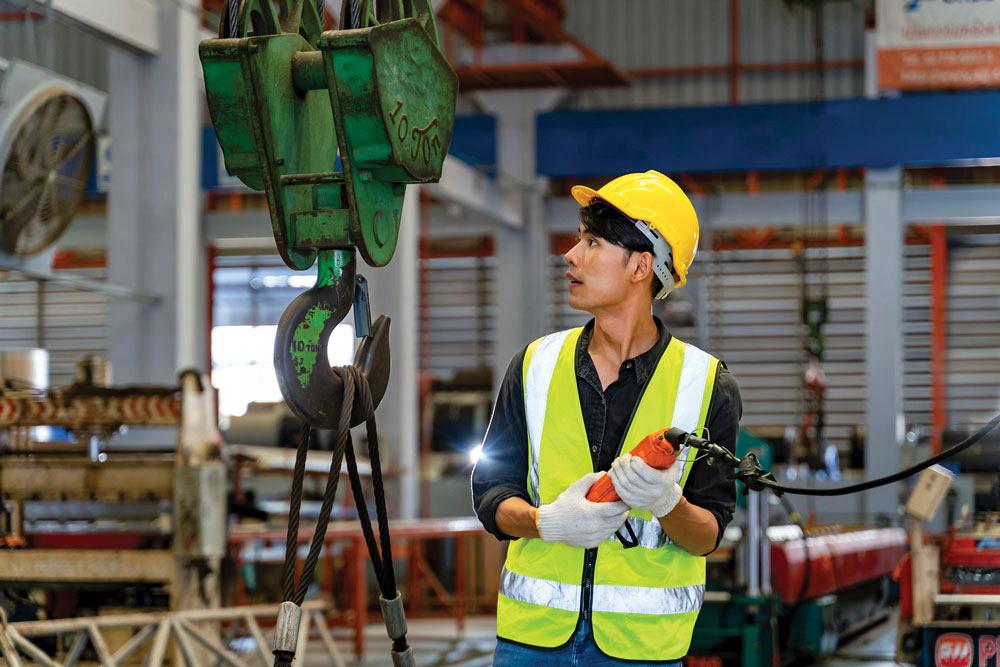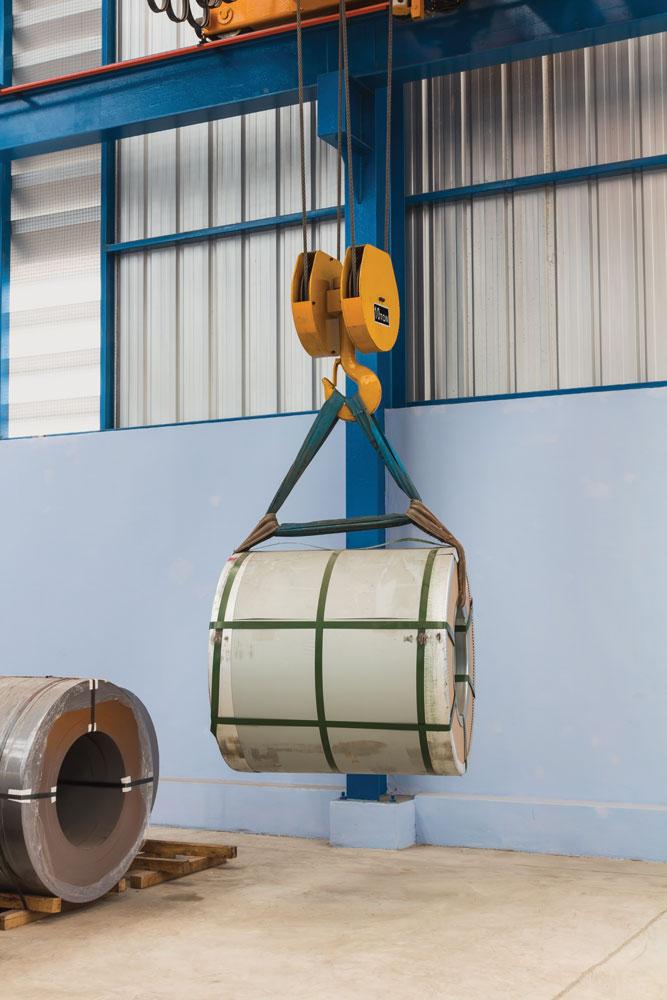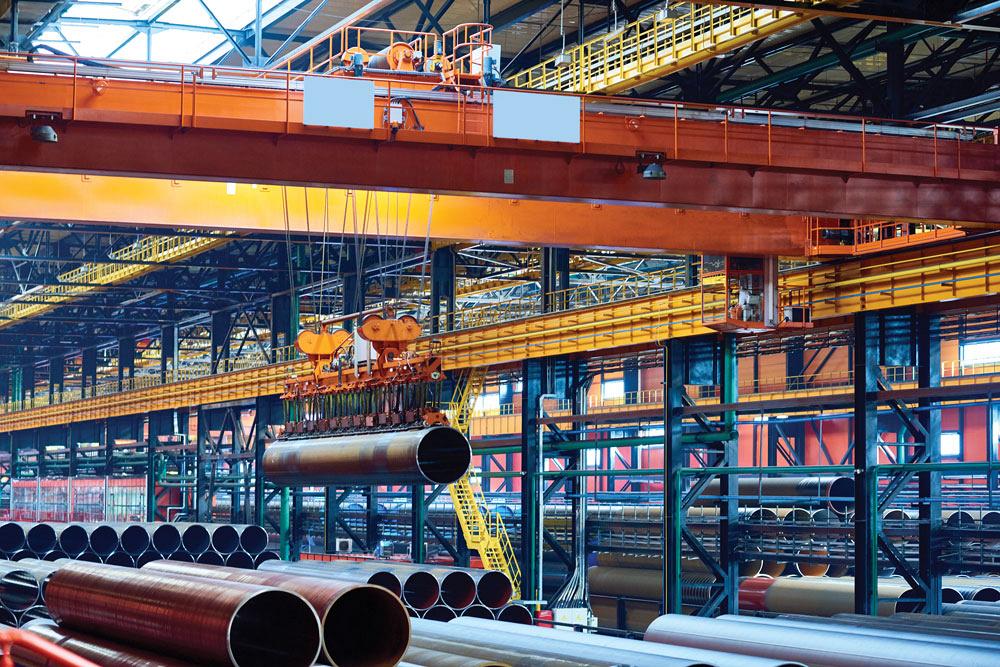Associate Editor
- FMA
- The Fabricator
- FABTECH
- Canadian Metalworking
Practice crane safety
Assess the potential risks and train crane operators in safe practices
- By Lindsay Luminoso
- November 24, 2022
- Article
- Automation and Software
Cranes, particularly overhead cranes, can be found in many fabricating shops. Fabricators use them to transport raw materials to shop floor machines and finished products to shipping bays to be sent out to customers. Material handling requires some thought to ensure that time and effort are being spent wisely. However, crane safety is paramount to all other aspects of the material handling process.
Shop Safety
Assessing the potential risks involved with crane operation is a good place for shops to start. Fabricators either can have management or a specific team come together to identify possible shop floor hazards.
“Shops can consult the crane manufacturer’s guidance as well as any established crane standards,” said Lin Yu, occupational health and safety specialist, Canadian Centre for Occupational Health and Safety (CCOHS), Hamilton, Ont. “From there, they should establish safe work procedures to address the identified hazards.”
After the initial risk assessment, fabricators should then implement a regular inspection and maintenance schedule for all crane components. This inspection should be based on regulatory requirements of the local legislation, the manufacturer’s guidance, as well as any industry standards such as CSA standards.
“Shops should not make temporary repairs to any hoisting or rigging equipment,” said Yu. “It's recommended to establish and follow a set procedure for proper repair. It’s important to have clearly defined procedures to guide the decision on whether the parts, material, or equipment can be repaired to be used safely again, or whether they are beyond repair and must be taken out of service.”
Having clear and proper signage that demonstrates all safety hazards, not just crane hazards, is a must. Signs should be large enough to identify areas of concern and should be followed by employees.
It’s really important for workplaces to perform a thorough risk and hazard assessment to determine potential dangers and the severity of their consequences, and to implement proper control measures. The goal of any shop, besides making money and good parts, is to ensure that it is a safe environment for employees.
Crane Safety Controls
Understanding the basic crane operation principles and knowing exactly where people ought to be in relation to a raised load is critical to crane safety.
“Fabricators should mark the areas in the shop where the crane will travel,” said Yu. “These danger zones should include signage and barriers to identify what hazards are present and prevent non-essential personnel from entering this area. It’s also important to ensure that employees are aware when loads are being moved so that they can stand clear when the load is being lifted, moved, lowered, or freed from links.”
Floor demarcations will help provide crane operators with a clear line of sight and ensure that the lifting area is clear of any debris or distractions, as the operator should be fully focused on the task at hand.

Crane operator training includes both theory and practical hands-on components. It can include sections on crane components and safety devices as well as principles of load handling and how to determine the lifting capacities. Akarawut Lohacharoenvanich/iStock /Getty Images Plus
“Every crane operator that goes into a shop needs to spend some time with either the foreperson or management,” said Joe Harnest, president, Crane Training Canada, Stoney Creek, Ont. “The foreperson should tell them about the hazards of any job they will be working on. There are hundreds if not thousands of different applications for cranes. Most of the standard cranes are able to do the work, but on occasion a special attachment may be needed to lift certain loads. All operators need to have specialized awareness of the hazards, especially non-standard hazards.”
On-site training is recommended for situations and applications that require specialized skills or present unique hazards. If an operator is expected to perform a particular task not covered in basic training, the trainer can work with the foreperson or supervisor to provide the operator with the appropriate knowledge of the situation.
“Crane operators are fully responsible for anything that could possibly happen when operating the crane,” said Harnest. “Before they lift the load up from the ground, they need to perform a thorough pre-shift check of the crane. This is not necessarily a difficult thing, but it can be repetitious and tedious and often there is no reward for this type of work. But it’s absolutely essential that the person performing the check be focused and aware of exactly what's going on with the crane.”
When it comes to crane operations, there are a few things that operators need to know before they begin. Understanding the weight of the load is essential. Harnest noted that the exact weight down to the pound does not necessarily need to be known, but operators should be able to accurately estimate what the crane will be moving.
“Another tip is to begin the lift by raising the load slightly at first to make sure that the load is free and that all the sling legs are taking the load,” said Yu. “It's also important to rig the loads to prevent any parts from shifting or dislodging during the lift. And remove all loose materials, parts, and blocking from the load before it’s lifted so nothing could fall during the lift.”
Technology improvements on cranes will help operators to move loads safely, but not all cranes have the latest safety features, and some safety features do come standard. For example, many overhead bridge cranes have regulated speeds.
“This means that acceleration and deceleration speeds are pre-set on the crane, with the principles needed to ensure there is no swing put into the crane,” said Harnest.
Crane Application Hazards
Overloading. This occurs when the load is heavier than the crane’s capacity, but it can also occur when the load is swinging, dragging, suddenly dropped, or its centre of gravity is not directly under the crane.
“Overloading can decrease the structural integrity of the crane and increase the chance of crane malfunction,” said Yu.
Falling/Dropping Load. Another potential hazard with crane operation is falling materials, which can result in serious injuries if someone is struck by or caught between falling objects.

There are many hazards associated with overhead crane operations including overloading, falling or dropping loads, sling angle, swing, and mechanical issues. Operator safety is paramount, and shops should have crane safety controls in place to limit hazards. teptong/iStock/Getty Images Plus
“Objects could fall because of improper or inadequate rigging or tying down of materials,” said Harnest. “It could be due to a mechanical failure of the lifting setup or even because of movement of the materials being lifted.”
Sling Angle. This is an important issue that many people with limited crane knowledge don’t fully understand.
A resultant sling angle is created when we start the sling at the crane hook going to the load on an angle, via I-bolt on top of the load going to the opposite side through an i-bolt and then back to the crane hook,” said Harnest. “With this particular setup, what appears to be a 45-degree angle because of the strains that are being put onto the sling is actually cut in half, well below what safety standards allow. People need to be aware of this particular situation in order to avoid a problem where we're going to be overloading the sling.”
Swing. One way or another, operators are bound to experience swing in the crane, and it's vitally important for them to know how to efficiently remove swing from a lift.
“The intent is, first of all, not to have a swing at all. But because of the many different situations that come up, on occasion, a crane operator most likely will come into a situation where there is swing, and he needs to know how to remove it.”
Guide Rope Availability. When approaching a load, it is important not to touch it or the rigging. A guide rope is always required.
“However, the challenge comes when there may not be a guide rope available,” said Harnest. “Somebody may have taken the guide rope, used it, put it down somewhere, and nobody knows exactly where it is. Without the guide rope, operators may be tempted to briefly touch the load, but this increases risk significantly.”
Guide ropes aren’t hugely efficient all of the time, especially when it comes to controlling the load. The guide rope can help with load rotation, but it only can be pulled, not pushed, for obvious reasons.
“This may mean that two or more operators, each with their own guide rope, are needed to control the load,” said Harnest. “Or, the alternative is to use a pole, which allows the operator to grab the load and push as well as pull it.”
Wear/Damage. It’s fairly common for equipment to experience wear and tear with day-to-day use. However, it is important to inspect the crane daily to ensure that no critical damage to the hoist or rigging equipment is present.
“Any sort of damage to the equipment should be categorized as either fixable—and fixed before the operator uses it—or damaged beyond repair and scrapped,” said Yu. “Working with damaged load-bearing equipment can affect their performance and potentially create safety hazards.”
Training and the Law
Training is so important for safe crane operations. Specific training requirements can vary across jurisdictions in Canada. It is important for fabricators to consult with the legislation and requirements that apply to them.
“But generally, training for personnel involved in crane operation aims to provide the necessary knowledge and skills for them to perform the task safely and effectively and to operate the equipment according to the manufacturer’s instructions as well as comply with applicable requirements and standards,” said Yu.
Having a comprehensive and up-to-date training program for crane operators and any other workers who are involved in hoisting and rigging is a good starting point.
Crane operator training generally involves both theory and practical hands-on components. It can include sections on crane components and safety devices as well as principles of load handling and how to determine the lifting capacities.
It also could include safe work practices, including the means of communication such as agreed upon signals and pre-operation inspections, and operating procedures and techniques that could include recognizing factors that can reduce the hoist capacity. There are so many potential hazards involved in crane operation that a periodic refresher training may be required to review critical knowledge and skills.
“Our program includes more specific application training,” said Harnest. “We teach how to estimate potential load weights based on the type of material so that operators have the inherent knowledge going out into the shop.”
Harnest also noted that training related to slings also is essential. Operators need to be comfortable assessing crane equipment and verifying that it is in working use.
“No operator should be afraid to remove a piece of equipment from service, but it does happen,” he said. “No one wants to be the bearer of bad news. Some forepersons or supervisors may not be happy that the equipment is out of service, but the primary concern should be for workers’ safety. If it’s a danger, the worker is protected by law and that operator should be congratulated for safe work practices. Crane operators and all workers need to be advocates for their own health and safety.”
Workplace laws are clearly defined and workers have a right to explore and examine them. For example, the Occupational Health and Safety Act in Ontario is structured specifically to have management and workers all on the same page when it comes to safety practices.
When it comes to safe crane operations, a shop that is dedicated to safety will have the necessary steps and procedures in place to ensure that projects are completed and crane operators have the tools they need to succeed.
Associate Editor Lindsay Luminoso can be reached at lluminoso@canadianfabweld.com.
CCOHS, ccohs.ca
Crane Training Canada, cranetrainingcanada .comAbout the Author

Lindsay Luminoso
1154 Warden Avenue
Toronto, M1R 0A1 Canada
Lindsay Luminoso, associate editor, contributes to both Canadian Metalworking and Canadian Fabricating & Welding. She worked as an associate editor/web editor, at Canadian Metalworking from 2014-2016 and was most recently an associate editor at Design Engineering.
Luminoso has a bachelor of arts from Carleton University, a bachelor of education from Ottawa University, and a graduate certificate in book, magazine, and digital publishing from Centennial College.
subscribe now


Keep up to date with the latest news, events, and technology for all things metal from our pair of monthly magazines written specifically for Canadian manufacturers!
Start Your Free Subscription- Industry Events
Automate 2024
- May 6 - 9, 2024
- Chicago, IL
ANCA Open House
- May 7 - 8, 2024
- Wixom, MI
17th annual Joint Open House
- May 8 - 9, 2024
- Oakville and Mississauga, ON Canada
MME Saskatoon
- May 28, 2024
- Saskatoon, SK Canada
CME's Health & Safety Symposium for Manufacturers
- May 29, 2024
- Mississauga, ON Canada





















